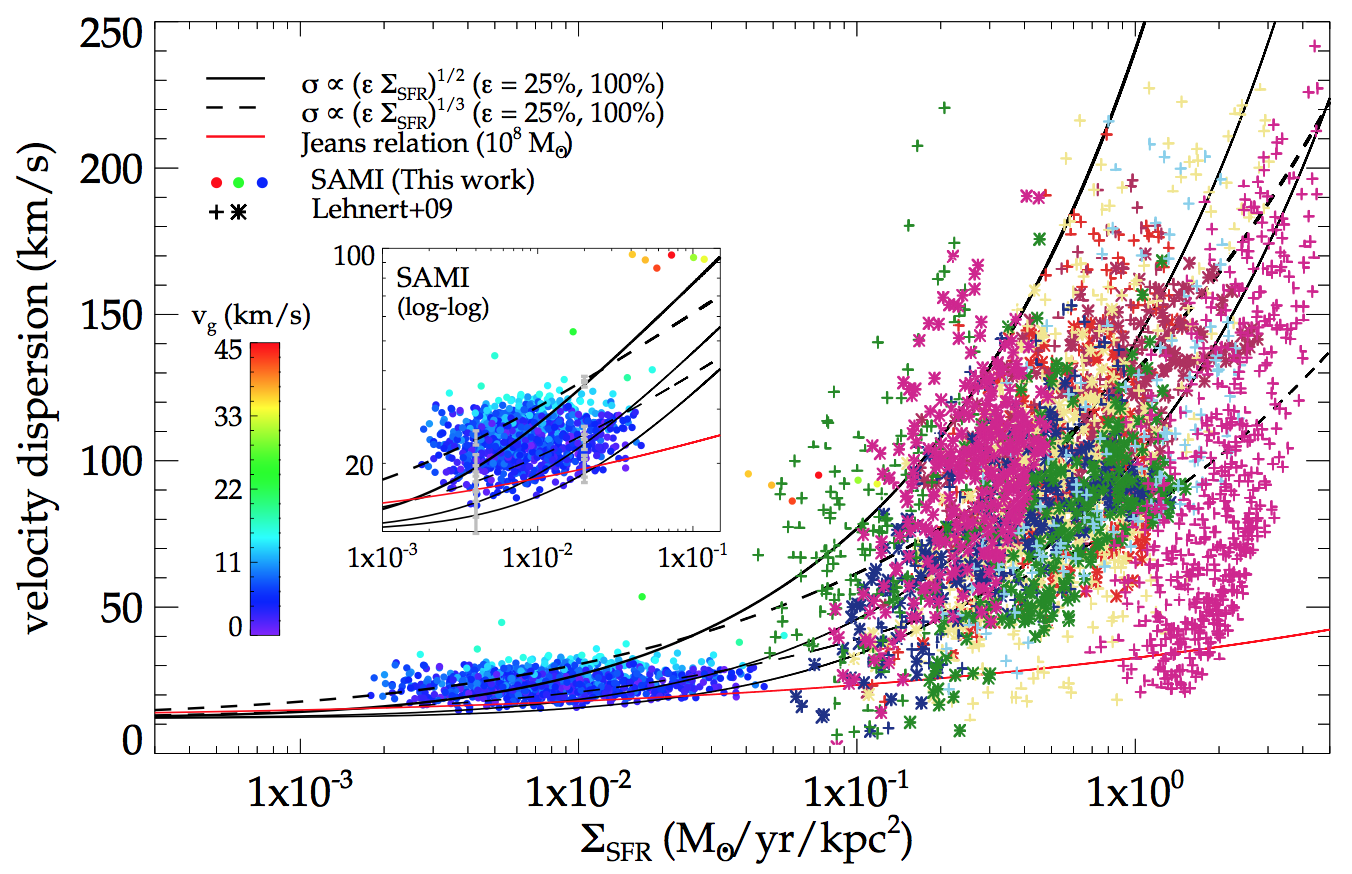
Contact Info
Australian National University
christoph.federrath@anu.edu.au
+61 (0)2 6125 0217
0000-0002-0706-2306
GitHub Bitbucket
We investigate the energy sources of random turbulent motions of ionised gas from H-alpha emission in eight local star-forming galaxies from the Sydney-AAO Multi-object Integral field spectrograph (SAMI) Galaxy Survey. These galaxies satisfy strict pure star-forming selection criteria to avoid contamination from active galactic nuclei (AGN) or strong shocks/outflows. Using the relatively high spatial and spectral resolution of SAMI, we find that - on sub-kpc scales our galaxies display a flat distribution of ionised gas velocity dispersion as a function of star formation rate (SFR) surface density. A major fraction of our SAMI galaxies shows higher velocity dispersion than predictions by feedback-driven models, especially at the low SFR surface density end. Our results suggest that additional sources beyond star formation feedback contribute to driving random motions of the interstellar medium (ISM) in star-forming galaxies. We speculate that gravity, galactic shear, and/or magnetorotational instability (MRI) may be additional driving sources of turbulence in these galaxies.

Spatially resolved gas velocity dispersion as a function of star formation rate surface density (Sigma_SFR) for purely star-forming SAMI galaxies at low redshift, compared to high-redshift galaxy data from Lehnert et al. (2009). Lines are theoretical models of velocity dispersion as a function of Sigma_SFR for star formation feedback (black solid line), dissipation of turbulence (dashed line), and gravity-driven turbulence (red solid line). At low Sigma_SFR, none of the theoretical models can explain the high level of turbulence (relatively high velocity dispersion) observed in some of the spaxel of the SAMI galaxies, which suggests that driving of turbulence by mechanisms other than feedback is required. Candidate drivers are sprial-arm shocks, galactic shear and magneto-rotational instability.
L.Z. and Y.S. acknowledge support for this work from the National Natural Science Foundation of China (NSFC grant 11373021) and the Excellent Youth Foundation of the Jiangsu Scientific Committee (grant BK20150014). C.F. gratefully acknowledges funding provided by the Australian Research Council's Discovery Projects (grants DP150104329 and DP170100603). Support for AMM is provided by NASA through Hubble Fellowship grant #HST-HF2-51377 awarded by the Space Telescope Science Institute, which is operated by the Association of Universities for Research in Astronomy, Inc., for NASA, under contract NAS5-26555. We thank R. Genzel, N. F\ouml;rster Schreiber, M.D. Lehnert, and N.P.H. Nesvadba for their support on providing high-z measurements displayed in this work. M.S.O. acknowledges the funding support from the Australian Research Council through a Future Fellowship (FT140100255). B.C. acknowledges support from the Australian Research Council's Future Fellowship (FT120100660) funding scheme. S.B. acknowledges the funding support from the Australian Research Council through a Future Fellowship (FT140101166). SFS thanks PAPIIT-DGAPA-IA101217 project and CONACYT-IA-180125. The authors would like to thank the anonymous reviewer for his/her helpful and constructive comments that greatly contributed to improving the final version of the paper. The SAMI Galaxy Survey is based on observations made at the Anglo-Australian Telescope. The Sydney-AAO Multi-object Integral field spectrograph (SAMI) was developed jointly by the University of Sydney and the Australian Astronomical Observatory. The SAMI input catalogue is based on data taken from the Sloan Digital Sky Survey, the GAMA Survey and the VST ATLAS Survey. The SAMI Galaxy Survey is funded by the Australian Research Council Centre of Excellence for All-sky Astrophysics (CAASTRO), through project number CE110001020, and other participating institutions. The SAMI Galaxy Survey website is https://sami-survey.org.